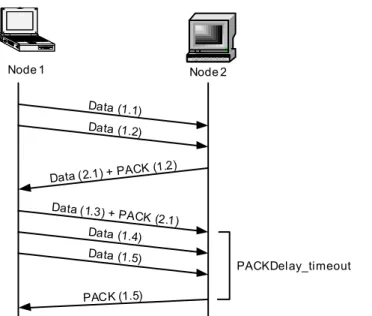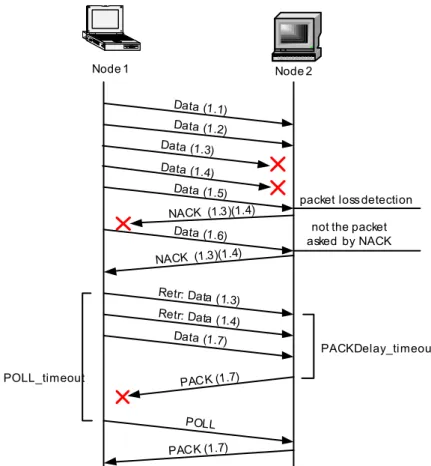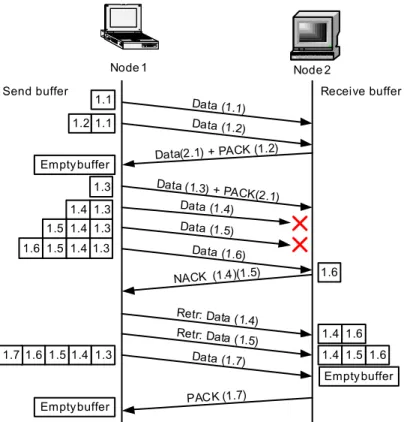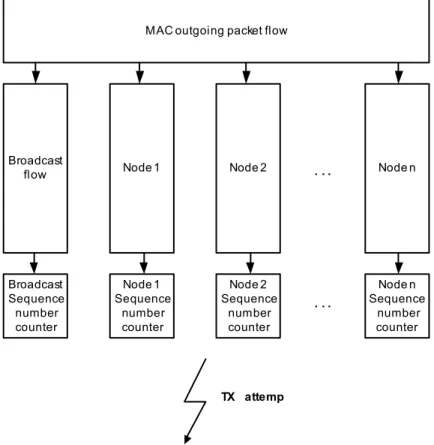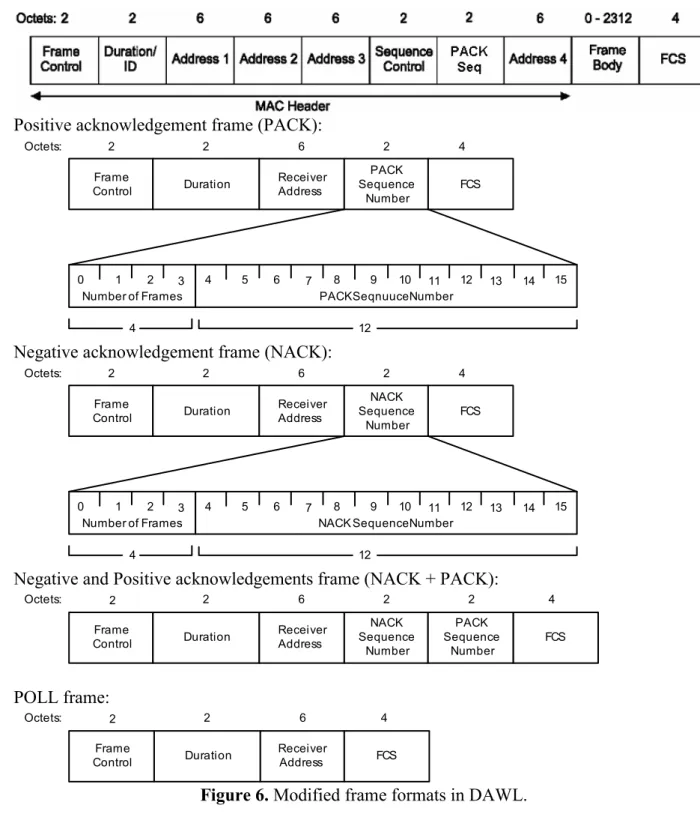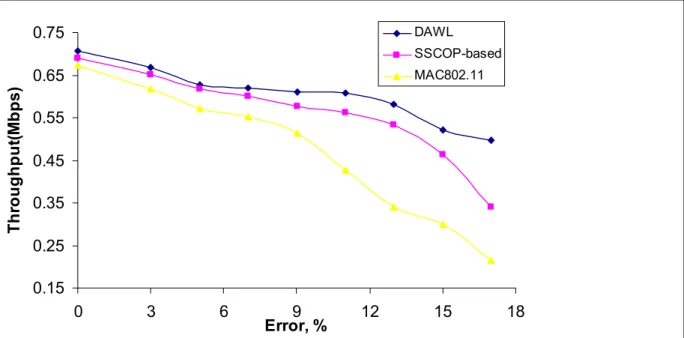UNIVERSITY
OF TRENTO
DEPARTMENT OF INFORMATION AND COMMUNICATION TECHNOLOGY
38050 Povo – Trento (Italy), Via Sommarive 14 http://www.dit.unitn.it
A DELAYED-ACK SCHEME FOR PERFORMANCE ENHANCEMENT OF WIRELESS LANS
Dzmitry Kliazovich and Fabrizio Granelli
July 2003
A Delayed-ACK Scheme for Performance Enhancement of
Wireless LANs
Dzmitry Kliazovich and Fabrizio Granelli DIT - University of Trento
Via Sommarive 14, I-38050 Trento (Italy) E-mail: [klezovic,granelli]@dit.unitn.it
Abstract – The IEEE 802.11 MAC protocol provides a reliable link layer using Stop & Wait ARQ. The cost for high reliability is the overhead due to acknowledgement packets in the direction opposite to the actual data flow. In this paper, the design of a new protocol as an enhancement of IEEE 802.11 is proposed, with the aim of reducing supplementary traffic overhead in order to increase the bandwidth available for actual data transmission. The performance of the proposed protocol is evaluated through comparison with IEEE 802.11 as well as with a SSCOP-based protocol. Results underline significant advantages of the proposed protocol against existing ones, thus confirming the value and potentiality of the approach.
Keywords – Wireless LAN, IEEE 802.11, Delayed ACK, ARQ scheme.
1 INTRODUCTION
In the past few years, wireless communication gained worldwide importance. In such framework, IEEE 802.11 standard [1] represents the leading MAC (Medium Access Control) protocol for wireless local area networks (WLAN). Packets can be lost due to errors, collisions and hidden nodes. 802.11 provides a reliable link layer by handling the packet delivery problems using a Stop&Wait ARQ (Automatic Repeat Request) scheme. This means that each transmitted packet must be acknowledged before the next packet can be sent. In IEEE 802.11 the receiver of the packet must reply with positive acknowledgement (PACK frame) to sender. The reception of this acknowledgement indicates successful frame transmission. If either the packet or its acknowledgement is lost, the sender of the packet will not receive any acknowledgement, and will retransmit the packet after the certain timeout period (ACK_Timeout).
The advantages of this scheme are the high reliability of data delivery and the ease of implementation. However, such ARQ scheme is inefficient as any other Stop & Wait scheme due to the idle time spent in waiting for the receiver acknowledgement after each transmission [2]. An experimental study of the IEEE 802.11 ARQ scheme is described in [3], where the weak spots of 802.11 ARQ are described when the reliability of the link layer is not acceptable for higher layer protocols such as TCP.
Several studies were performed for improvement of the performance of 802.11 logical link control via modification of its ARQ scheme. The alternative local area network protocol proposed in [4] and Enhanced Retransmission Scheme [5] were designed to reduce the number of control frames used for single-packet delivery. A new SSCOP-based protocol was proposed in [6] for the improvement of the acknowledgement scheme, aimed at the reduction of overhead due to acknowledgements. It becomes possible by collecting the acknowledgement information on the receiver side and then sending it by one control frame after being polled by transmitter. This technique is already implemented in ATM networks and known as Service Specific Connection Oriented Protocol (SSCOP).
This paper presents a new approach to the reduction of the acknowledgement overhead for improvement of the throughput in wireless channels with various error rates. The proposed protocol, that can be considered as a modification of the original 802.11 standard, exploits the
main concepts of the TCP Delayed-ACK scheme as well as a negative acknowledgement technique.
The rest of the paper is organized as follows. In section 2 the proposed scheme is introduced in details, first by introducing the main concepts and features of the protocol and then by describing the modifications required to 802.11. Performance evaluation through simulation is presented in section 3. Finally conclusions and outlines about future work on the topic are proposed in sections 4 and 5.
2 DESCRIPTION OF THE PROPOSED METHOD
General Description
The proposed protocol Delayed-ACK for Wireless LANs (DAWL) is a combination of the TCP Delayed-ACK scheme and the SSCOP-based protocols. The main concept behind the proposed method is that the receiver does not acknowledge the packets delivery immediately, but it delays their acknowledgement. Assuming to have data going in the opposite direction, the acknowledgement can be sent together with data packet for decreasing the overall packet delivery time. To this aim, Positive ACKnowledgements (PACK) are used to acknowledge the data packet delivery and Negative ACKnowledgements (NACK) to request retransmission of missing packets.
In the following, we assume that there is only a single link between the transmitter and the receiver, because there is only one station is allowed to transmit at certain moment of time, in order to ease the presentation of the proposed approach. In case more then one transmitter is working at the same moment there will be a collision which causes packet drops. This means that all transmitted packets are going continuously one-by-one. It is possible to detect packet losses by analyzing the order of sequence number of the received packets. When a missing packet is detected, the receiver sends a NACK message, mentioning the sequence number and the amount of missed packets immediately to let the sender to retransmit missed packets. The packets for positive and negative acknowledgement are control packets of MAC layer and they are to be transmitted after the Sort Inter Frame Space (SIFS) time interval.
Figure 1 shows an example of the basic operations of DAWL protocol. The data packets Data (1.1) and Data (1.2) from node 1 are received by node 2 without acknowledgement, until there is a data packet Data (2.1). Then, PACK (1.2) is transmitted together with this data packet in order to acknowledge the previously received frames. Since Node 2 has no additional data to send, acknowledgements to be sent to Node 1 are collected and when the PACKDelay_timeout expires, Node 2 reports to Node 1 about successful reception of last frames (3), (4) and (5) by the transmission of PACK(1.5) control packet.
The difference with MAC802.11 protocol is the same as in case of SSCOP-based protocol – elimination of ACK timeout and reduction of the medium-busy time, which is required for every (except broadcast) data packet acknowledgement. The difference with SSCOP-based protocol presented in [6] is in elimination of control packets transmission such as STAT. In [6], in fact, after sending the specified amount of data frames the transmitter will wait for the STAT frame from the receiver in SSCOP-based protocol. The STAT frame is a control frame of variable length which is to be sent after SIFS without medium reservation by Network Allocation Vector (NAV). Its elimination will decrease the probability of collision in the medium. In DAWL, on the contrary, in most of the cases data packets present in both directions and acknowledgements go along with data packets.
Data (1.1) Data (1.2) Data (1.3) + PACK (2.1) Data (2.1) + PACK (1.2) PACK (1.5) Data (1.4) Data (1.5) Node 2 PACKDelay_timeout Node 1
Figure 1. An example of the basic mode of operations in DAWL. Error recovery in the DAWL protocol
In case of operation in channels with errors (like wireless LANs), DAWL protocol provides a fast error recovery mechanism that enables keeping total throughput on a high rate. Figure 2 displays an example of operation in different error scenarios. When the receiver detects the loss of data packets Data (1.3) and Data (1.4), it informs the sender by sending a retransmission request for the missed packets. It is possible to request more then one packet because NACK contains a sequence number and the amount of packets to be retransmitted. After the reception of NACK, sender must retransmit the requested packets. In case there is no retransmission caused by NACK, but there is a continuation of data flow, NACK request must be repeated (fig. 2).
After successful retransmission of the lost frames, transmitter’s data flow continues. If sender has not received positive acknowledgement for the transmitted data within POLL_timeout time, it will poll the receiver by transmission of POLL frame. Upon reception of the POLL frame, receiver must immediately respond with PACK. The main differences with SSCOP-based protocol are:
- possibility of requesting more then one frame for retransmission;
- sender is not freezing a data flow while waiting for the acknowledgement for the sent packets;
- retransmission of POLL using SSCOP-based protocol takes much more channel resources then retransmission of POLL frame in the proposed protocol, because it is just a control packet.
The reader should note that the POLL frame in DAWL protocol will not appear in usual data exchange even with low percent of errors. It is added to handle non-standard situations when there are no acknowledgements from the receiver for a long time.
Data (1.1) Data (1.2) Retr: Data (1.3) NACK (1.3)(1.4) Retr: Data (1.4) Data (1.7) Node 2 Node 1 Data (1.3) Data (1.4) Data (1.5) Data (1.6) NACK (1.3)(1.4)
packet loss detection not the packet asked by NACK PACK (1.7) POLL PACK (1.7) PACKDelay_timeout POLL_timeout
Figure 2. Examples of error events and recovery in DAWL. NAV modification
The elimination of ACK frame in data frame transmission scheme of 802.11 requires a modification in the NAV value calculations (see figure 3). Modified NAV will not include SIFS interval and ACK frame durations as it is shown on the figure X. POLL frame includes NAV for SIFS and PACK answer durations. The contention for wireless LANs is still exactly the same as in MAC802.11. RTS CTS DATA NAV(RTS) NAV(CTS) SIFS SIFS Source Destination NAV RTS CTS DATA NAV(RTS) NAV(CTS) SIFS SIFS Source Destination NAV ACK SIFS MAC802.11 DAWL NAV difference
Timeouts
The DAWL protocol provides a reliable link layer. However, some data packets and acknowledgements can be lost. POLL_timeout is used to handle the situation of missing acknowledgements and its expiration causes generation of POLL frame by sender to get the status information from the receiver. This is the only time when a POLL frame can appear in packet exchange.
There is one more timer PACKDelay_timeout that is similar to the TCP Delayed ACK. During this time a node deliberately delays sending ACK assuming it can send the data along with ACK. In case there is no data to send, it will send a standalone ACK.
Such timers should be configured to trigger retransmission before higher layer timeout occurs. The POLL_timeout value must be bigger then PACKDelay_timeout in order to eliminate the transmission of unnecessary POLL frames.
The determination of PACKDelay_timeout has to be considered depending of the channel current error rate.
Buffer management
All data packets to be sent must be placed in buffer before transmission. They can be deleted from the buffer after their successful acknowledgement was received. On the receiver side, when a packet loss is detected, all frames from this time are to be put to the buffer until missed frames are retransmitted and successfully received. As it is shown on Figure 4, frames 1.1 and 1.2 are buffered at the transmitter until PACK received within data packet 2.1. Receiver detects a frame loss when frame 1.6 is received, it puts it into the buffer as well as retransmitted packets 1.4 and 1.5. Then when frame 1.7 was received, the receiver releases this buffer. Finally, upon reception of the PACK standalone frame, the sender deletes successfully transmitted frames from the buffer. Data (1.1) Data (1.2) Data(2.1) + PACK (1.2) Retr: Data (1.4) Data (1.7) Node 2 Node 1 Data (1.5) Data (1.4) Data (1.3) + PACK(2.1) Data (1.6) NACK (1.4)(1.5) PACK (1.7) Retr: Data (1.5)
Send buffer Receive buffer
1.1 1.1 1.2 Empty buffer 1.3 1.3 1.4 1.3 1.4 1.5 1.3 1.4 1.5 1.6 1.3 1.4 1.5 1.6 1.7 Empty buffer 1.6 1.6 1.4 1.6 1.5 1.4 Empty buffer
REQUIRED MODIFICATIONS OF IEEE 802.11 MAC PROTOCOL
Sequence number management
The IEEE 802.11 standard assigns a sequence number to every data packet. After transmission of the current packet, a sequence number counter (SNC) is increased modulo 4096. The packet loss detection and further retransmission of the lost packets in the DAWL protocol are based on the analysis of the packet sequence number order. In order to have an uninterrupted increase of sequence number in data exchange between two nodes, DAWL protocol needs to modify the original 802.11 scheme. Each node of the network should have one SNC for broadcast packets and one SNC for each node to which the current node is making packet exchange at present moment. It means when a node has a necessity to send data to any other node it allocates a new SNC. When the data exchange with that node is finished it can release the allocated resources. A block scheme of such concept is shown on figure 5.
MAC outgoing packet flow
Broadcast flow Broadcast Sequence number counter Node 1 Node 1 Sequence number counter Node 2 Sequence number counter Node 2 . . . . . . Node n Sequence number counter Node n TX attemp
Figure 5. Sequence number management in DAWL. Frame formats
In the DAWL protocol, 5 new packet types are introduced:
- Data + ACK frame to carry positive acknowledgement information about the received frames;
- ACK frame as a standalone packet;
- NACK frame to inform the sender about a frame loss;
- NACK + ACK frame as a combination of ACK and NACK frames, to decrease the number of small packets in the channel;
- POLL frame to request receiver status information.
All the designed packet types are compatible with IEEE 802.11.
The framework of the new packets is represented on the figure 6, while the newly defined frame types are in the table I.
Positive acknowledgement frame (PACK): Frame Control Duration Receiver Address PACK Sequence Number FCS 2 2 6 2 4 Octets: Number of Frames 0 1 2 3
PACK Seqnuuce Number
4 5 6 7 8 9 10 11 12 13 14 15
4 12
Negative acknowledgement frame (NACK):
Frame Control Duration Receiver Address NACK Sequence Number FCS 2 2 6 2 4 Octets: Number of Frames 0 1 2 3
NACK Sequence Number
4 5 6 7 8 9 10 11 12 13 14 15
4 12
Negative and Positive acknowledgements frame (NACK + PACK):
Frame Control Duration Receiver Address NACK Sequence Number FCS 2 2 6 2 4 Octets: PACK Sequence Number 2 POLL frame: Frame Control Duration Receiver Address FCS 2 2 6 4 Octets:
Figure 6. Modified frame formats in DAWL.
TABLE I. FRAME TYPE IDENTIFIERS IN THE DAWL PROTOCOL. Frame Type Type Subtype
Data + PACK 10 1000 PACK 01 1001 NACK 01 0110 NACK + PACK 01 1010 POLL 01 0010
3 PERFORMANCE EVALUATION
We analyzed the performance of the proposed protocol by simulating experiments using ns-2 [7]. Most of the results are achieved in grid topology where there are two static nodes are in TCP
connection. One of them continuously sends data, while the other one replies only by TCP acknowledgements, which are usual data frames for the layer in which our protocol operates. Figure 7 illustrates the protocol stack of this model in ns-2 simulator.
The DAWL protocol operation was also tested in multi-flow environment where there are N TCP flows produced by 2*N nodes, where N is from 1 to 10. This scenario clarified conceptual similarity with the two-node scenario.
The throughout of TCP connections is chosen as the main parameter for the performance analysis. We compared the proposed protocol with IEEE 802.11 [1] as well with the SSCOP-based protocol presented in [6].
Figure 8 shows the simulation results. As the error rate increases, DAWL protocol has an increasing advantage comparing to 802.11 MAC and SSCOP-based protocols. The main reason why the proposed protocol achieves higher throughput in comparison with SSCOP-based protocol is the elimination of sending control frames, the improved retransmission algorithm and no delays in data transmission while waiting for the acknowledgement of sent data frames. The difference with IEEE 802.11 is mainly due to the significant improvement of the acknowledgement scheme, which leads to faster data exchange between nodes. Some numerical results are presented in table II.
Node 1 DAWL Protocol TCP Agent Node 2 DAWL Protocol TCP Sink Data Agent Link Link Layer (MAC Layer) Netw ork Layer
Layer 4
TCP Data flow TCP ACK flow
Figure 7. Protocol stack of two-node scenario model in ns-2 simulator.
TABLE II. EXPERIMENTAL RESULTS OF TESTED PROTOCOLS
Throughput, Mbps
Error, % DAWL SSCOP MAC 802.11
0 0.7068 0.6907 0.6739 3 0.667 0.6506 0.6185 5 0.6272 0.6175 0.5725 7 0.6206 0.6005 0.5522 9 0.611 0.5771 0.5141 11 0.6078 0.5617 0.4262 13 0.581 0.5335 0.3404 15 0.5219 0.4621 0.2983 17 0.4976 0.3412 0.2149
0.15 0.25 0.35 0.45 0.55 0.65 0.75 0 3 6 9 12 15 18 Error, % Thr oughput (M bps ) DAWL SSCOP-based MAC802.11
Figure 8. Performance comparison in terms of throughput among 802.11, SSCOP-based and
DAWL protocols.
The percentage of the improvement of the DAWL protocol over the other approaches is shown in figure 9.
The average throughput improvement of DAWL protocol in the interval from 0 to 10 percent of error rate of total channel bandwidth is 3.128 percent comparing with SSCOP-based protocol and 10.70 percent for IEEE 802.11 MAC protocol. In case of high error rate in the channel DAWL protocol has more advantages. For the interval from 10 to 17 percent the throughput improvements are in average 18.97 percent for SSCOP-based protocol and 79.95 percent for IEEE 802.11 MAC.
Again, the advantage of DAWL protocol is as bigger as channel error rate grows.
0 20 40 60 80 100 120 140 0 2 4 6 8 10 12 14 16 18 Error rate, % Im p ro vem en t, % SSCOP-based MAC802.11
4 CONCLUSIONS
This paper presented DAWL protocol as an enhancement of the IEEE 802.11 MAC, proposing the combination of the Delayed-ACK and negative acknowledgement techniques as a new alternative ARQ scheme. We evaluated the performance of the proposed protocol and compared the results with IEEE 802.11 MAC as well as with a SSCOP-based protocol. Results underline the significant advantage of the designed protocol in different conditions.
5 FUTURE WORK
The DAWL protocol has obvious advantages in dual direction traffic exchange. The evaluation was carried out in scenario when there is a TCP connection between two wireless nodes. Further performance evaluation is required for different kinds of TCP protocols to determine the impact of the transport protocol over the performance on the wireless link. It is necessary as well to optimize the parameters of the DAWL protocol in a multi-node error-prone wireless network. Finally we are going to evaluate the DAWL protocol in the environment of big amount of small packets with delays like typical web session of HTTP protocol.
REFERENCES
[1] “Wireless LAN Medium Access Control (MAC) and Physical Layer (PHY) Specifications,” IEEE 802.11 standard, 1997.
[2] Medeiros de Lima, H. and Duarte O.C.M.B., “An Effective selective repeat ARQ strategy for high speed point-to-multipoint communications”, Global Telecommunications Conference, 1996. GLOBECOM '96.
[3] Chung Ho Nam, Soung C. Liew, Cheng Peng Fu, "An Experimental Study of ARQ Protocol in 802.11b Wireless LAN".
[4] B.E. Mullins, N.J. Davis, S.F. Midkiff, “A wireless local area network protocol that improves throughput via adaptive control”, IEEE International Conference on Communications (ICC’97). [5] H.-L. Wang, J. Miao, J. Morris Chang, “An Enhance IEEE 802.11 Retransmission Scheme”, Proc. of IEEE Wireless Communication and Networking Conference (WCNC’03), 2003.
[6] H.-L. Wang, A. Velayutham, “An SSCOP-based Link Layer Protocol for Wireless LANs”. [7] NS-2 simulator tool home page. http://www.isi.edu/nsnam/ns/, 2000.
